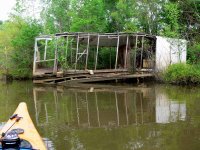Launch: Cliffs in Baldwin County off Hwy 225.
Fee: Free.
Route: North about 2.5 miles on the Tensaw River, then split right into Dennis Lake, then about 1.5 miles to The Cutoff which is to the left. Up The Cutoff another two miles to where it is blocked by a mass of trees that are blown over, then back to Dennis Lake. Dennis Creek is to the right about a quarter mile past The Cutoff. Up Dennis Creek about 1.25 miles, plus explored some tributaries.
Distance: 16.7 miles round trip.
Average Speed: 2.3 mph.
Time: Approx 7.5 hrs.
Pace: Slow.
Weather: Temp 70-80 degrees, partly cloudy, calm morning but strong breezy winds out of the south in the afternoon.
Kayak Type: Used a paddle kayak today due to the shallow waters and hidden tree stumps. I was exploring The Cutoff tributary which I’d never been in before and found very beautiful and boat free. The same for Dennis Creek.

 (1) Above left.
(1) Above left. After launching, I crossed the Tensaw River in order to watch the glowing sunrise and it was well worth getting up early to experience it. (Click on photos to view larger image.)
(2) Above right. A little later the sun finally peeks over the tree tops.

 (3) Above left.
(3) Above left. About an hour after sunrise, I reached the entrance to Dennis Lake. It was remarkable how slick the Tensaw River was because no boats had gone by yet.
(4) Above right. An old hunting or fishing shack that the swamp is slowly devouring.

 (5) Above left.
(5) Above left. Wisteria or some type of pea family flower. The colors remind me of Easter Sunday.
(6) Above right. A bottom view of a Leatherflower, aka Clematis viornia. Some of the other flowers I saw today were yellow pond lilies, fragrant water lilies, floating bladderworts, violets, butterweed, and never wet.

 (7) Above left.
(7) Above left. Here I was exploring up a small tributary and this is typical of what the upper Cutoff and Dennis Creek areas look like.
(8) Above right. All day long song birds, like this Prothonotary Warbler, were singing so much that I can still hear them even though I’m sitting at home now. Also saw a scissor tail kite, hawks, cardinals, and other birds today.

 (9) Above left.
(9) Above left. A small Pearly Crescentspot butterfly.
(10) Above right. Dragonflies, aka Mosquito Dragons, can be quite entertaining at times, like when they go flying into the water.

 (11) Above left.
(11) Above left. A red-bellied woodpecker was making his morning rounds, quite noisily.
(12) Above right. A big-eyed yellow-crowned night heron that was fixated on the big orange kayak as it went under its nest.

 (13) Above left.
(13) Above left. “He’s back…” This looked like the same humongous alligator I saw back on March 11. If it is, the alligator has moved about 5 miles to another stream.
(14) Above right. On day long trips it is necessary to get out of the kayak from time to time to stretch the legs. Here I am taking a break.
The birds make merry music but, at times, when I glide silently around the next bend in the creek, a noise in nearby bushes raises the hair on my arms. Could it be something I've never seen like a bear or panther? Maybe the sound is from a humongous alligator or wild pig ready to pounce? Now I find it necessary to focus intensely on where the sound came from and then finally see a tiny bird fly away. Whew! Tiny birds can make big noise. I take a few more paddle strokes and again glide silently along shallow, narrow streams where no power boats go. In a kayak, I sit in the water so to speak, hands at water level, and then all of a sudden a big fish slaps its tail making a huge splash right next to me and I about jump out of my skin. Whew! At times the swamp can be so peaceful and beautiful. Other times I question my sanity for going into such a wild environment. Maybe that is why I love exploring the Mobile-Tensaw River Delta by kayak because, it is both beautiful and exciting. Every kayaking trip is an adventure and I’m glad some of you are enjoying my adventures.



















































